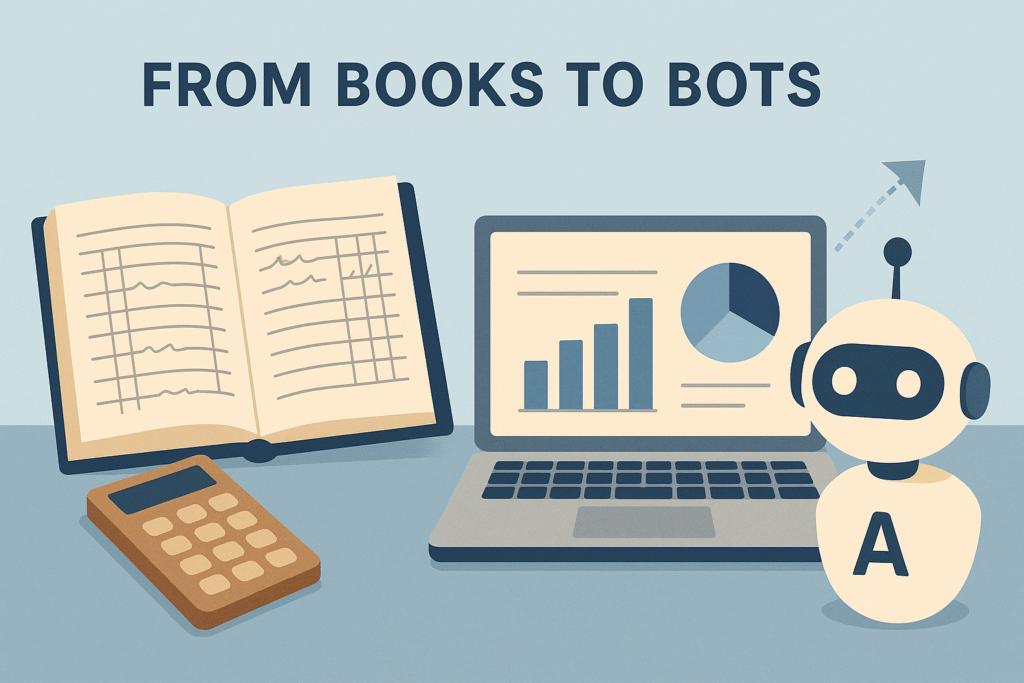This post is also available in:
Bahasa Malaysia
Accounting has evolved rapidly — from manual recordkeeping in dusty ledgers to intelligent systems that automate tasks and provide real-time financial insight. For years, the latest accounting technology was only accessible to large corporations. Today, that’s no longer the case.
Thanks to cloud computing and AI, powerful tools are now within reach for small and medium-sized enterprises (SMEs), offering not only automation but also strategic insights that help them operate with the same sophistication as larger businesses. These tools are not just affordable — they’re essential for growth, agility, and long-term competitiveness.

In this post, we’ll explore the key milestones that have shaped accounting technology and explain why SMEs should embrace the shift. The pace of change is accelerating — and those who adapt will thrive.
The Evolution of Accounting Technology: A Timeline
Pre-1950s: Manual Bookkeeping
- Accounting was entirely handwritten in physical ledgers.
- Double-entry bookkeeping ruled, but everything was done manually — slow, error-prone, and labor-intensive.
1950s–1970s: Mainframe & Early Computing
- Large enterprises began using mainframe computers for batch processing of payroll and financial reports.
- These systems were expensive and inaccessible to small businesses.
1980s–1990s: PC Revolution & Computerised Accounting
- Affordable personal computers brought accounting software like MYOB, Peachtree, and QuickBooks.
- SMEs could now digitize their bookkeeping and streamline basic tasks.
- Data remained stored locally, requiring backups and updates.

2000s: Internet & Cloud Adoption Begins
- Cloud-based solutions emerged, allowing businesses to access their accounts anywhere, anytime.
- No need for software installation or manual updates.
- SMEs gained access to tools once only available to larger firms.
2010s: Cloud Accounting Matures
- Cloud platforms like Xero, QuickBooks Online, and Wave gained traction.
- Integration with banking, invoicing, inventory, and payroll systems became standard.
- Real-time collaboration with accountants and advisors became possible.
2020s: AI-Powered Accounting
- AI and machine learning now automate routine tasks like expense categorization, bank reconciliation, and data entry.
- Predictive insights, cash flow forecasting, and anomaly detection help SMEs make smarter financial decisions.
- Virtual assistants and chatbots simplify support and daily tasks.
Why SMEs Should Embrace Modern Accounting Tech
- Affordability: Cloud and AI tools have dropped in cost, making them accessible to even the smallest businesses.
- Efficiency: Automation frees up valuable time previously spent on manual tasks.
- Real-Time Decision-Making: Instant access to financial data helps business owners respond quickly to changes.
- Competitive Edge: SMEs can now match the financial management capabilities of much larger companies.
- Scalability: Modern tools grow with your business, reducing the need for major tech overhauls later.
Final Thoughts
The evolution of accounting isn’t slowing down — it’s accelerating. SMEs that embrace cloud and AI-powered solutions are positioning themselves to not only survive but thrive in a fast-changing business environment.
Whether you’re still using spreadsheets or already on a cloud platform, now is the time to evaluate how your accounting tech stack can better support your business goals. The tools are here — and they’re built for businesses like yours.